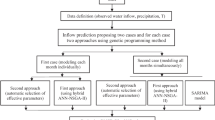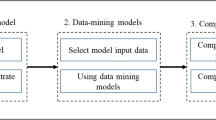Abstract
Urban wastewater discharge is one of the most important components for the development and design of water and wastewater treatment projects. In this study, the daily urban wastewater discharge (UWD) was predicted using two artificial intelligent models including the multilayered perceptron neural network (MLPNN) and genetic programming (GP). For this purpose, Kerman’s (Kerman city located in the south-east of Iran) sewage data, which have been recorded daily in the last 5 years, were used. To design the input pattern of the models, up to four-time delays units were considered. The results of both models declared that two delay units are enough for modeling and prediction of the UWD. The developed MLPNN model consists of two hidden layers. The first and second hidden layers have seven and five neurons, respectively. The tangent sigmoid was considered as transfer function governing the equation on neurons. The error indices of developed MLPNN in testing stages are R2 = 0.77 and RMSE = 1589. The structure of the mathematical model developed based on genetic programming has three genomes whose structure consists of two units of time delay. The accuracy of GP modeling is acceptable; however, its precision is a bit less than the MLPNN, but its results are more practical.







Similar content being viewed by others
Abbreviations
- ANFIS:
-
Adaptive neuro-fuzzy inference system
- BOD:
-
Biochemical oxygen demand
- COD:
-
Chemical oxygen demand
- DL:
-
Longitudinal dispersion coefficient
- GP:
-
Genetic programming
- GP:
-
Genetic programing
- MLPNN:
-
Multilayered perceptron neural network
- MLPNN:
-
Multilayered perceptron neural network
- PCA:
-
Principal component analysis
- TSS:
-
Total suspended solids
- UWD:
-
Daily urban wastewater discharge
- WWTP:
-
Wastewater treatment plants
References
Bagheri M, Mirbagheri SA, Bagheri Z, Kamarkhani AM (2015) Modeling and optimization of activated sludge bulking for a real wastewater treatment plant using hybrid artificial neural networks-genetic algorithm approach. Process Saf Environ Prot 95:12–25
Clark RM, Hakim S, Ostfeld A (2011) Handbook of water and wastewater systems protection. Springer, New York
Dellana SA, West D (2009) Predictive modeling for wastewater applications: linear and nonlinear approaches. Environ Model Softw 24(1):96–106
Federation WE (2012) Design of municipal wastewater treatment plants MOP 8, 5th edn. McGraw-Hill Education, New York
Federation WE, Design WEFTFoWTP (2012) Wastewater treatment plant design handbook. Water Environment Federation
Güçlü D, Dursun Ş (2010) Artificial neural network modelling of a large-scale wastewater treatment plant operation. Bioprocess Biosyst Eng 33(9):1051–1058
Haghiabi AH (2016) Prediction of longitudinal dispersion coefficient using multivariate adaptive regression splines. J Earth Syst Sci 125(5):985–995. https://doi.org/10.1007/s12040-016-0708-8
Haghiabi AH, Nasrolahi AH, Parsaie A (2018) Water quality prediction using machine learning methods. Water Qual Res J 53(1):3–13
Hayder G, Ramli M, Malek M, Khamis A, Hilmin N (2014) Prediction model development for petroleum refinery wastewater treatment. J Water Process Eng 4:1–5
Kasiviswanathan KS, Saravanan S, Balamurugan M, Saravanan K (2016) Genetic programming based monthly groundwater level forecast models with uncertainty quantification. Model Earth Syst Environ 2(1):27. https://doi.org/10.1007/s40808-016-0083-0
Lerner DN, Yang Y, Barrett MH, Tellam J (1999) Loadings of non-agricultural nitrogen in urban groundwater. IAHS Publication, Wallingford, pp 117–124
Mjalli FS, Al-Asheh S, Alfadala H (2007) Use of artificial neural network black-box modeling for the prediction of wastewater treatment plants performance. J Environ Manag 83(3):329–338
Najafzadeh M, Zeinolabedini M (2018) Derivation of optimal equations for prediction of sewage sludge quantity using wavelet conjunction models: an environmental assessment. Environ Sci Pollut Res 25(23):22931–22943. https://doi.org/10.1007/s11356-018-1975-5
Najafzadeh M, Zeinolabedini M (2019) Prognostication of waste water treatment plant performance using efficient soft computing models: an environmental evaluation. Measurement. https://doi.org/10.1016/j.measurement.2019.02.014
Nasr MS, Moustafa MA, Seif HA, El Kobrosy G (2012) Application of Artificial Neural Network (ANN) for the prediction of EL-AGAMY wastewater treatment plant performance-EGYPT. Alexandria Eng J 51(1):37–43
Nourani V, Elkiran G, Abba S (2018) Wastewater treatment plant performance analysis using artificial intelligence—an ensemble approach. Water Sci Technol 78(10):2064–2076
Parsaie A (2016) Predictive modeling the side weir discharge coefficient using neural network. Model Earth Syst Environ 2(2):63. https://doi.org/10.1007/s40808-016-0123-9
Parsaie A, Haghiabi AH (2015) Predicting the longitudinal dispersion coefficient by radial basis function neural network. Model Earth Syst Environ 1(4):34. https://doi.org/10.1007/s40808-015-0037-y
Parsaie A, Najafian S, Shamsi Z (2016) Predictive modeling of discharge of flow in compound open channel using radial basis neural network. Model Earth Syst Environ 2(3):1–9. https://doi.org/10.1007/s40808-016-0207-6
Parsaie A, Emamgholizadeh S, Azamathulla HM, Haghiabi AH (2018) ANFIS-based PCA to predict the longitudinal dispersion coefficient in rivers. Int J Hydrol Sci Technol 8(4):410–424
Vesilind P (2003) Wastewater treatment plant design. vol. 2. Water Environment Federation
Zeinolabedini M, Najafzadeh M (2019) Comparative study of different wavelet-based neural network models to predict sewage sludge quantity in wastewater treatment plant. Environ Monit Assess 191(3):163. https://doi.org/10.1007/s10661-019-7196-7
Author information
Authors and Affiliations
Corresponding author
Additional information
Publisher's Note
Springer Nature remains neutral with regard to jurisdictional claims in published maps and institutional affiliations.
Rights and permissions
About this article
Cite this article
Mansour-Bahmani, A., Haghiabi, A.H., Shamsi, Z. et al. Predictive modeling the discharge of urban wastewater using artificial intelligent models (case study: Kerman city). Model. Earth Syst. Environ. 7, 1917–1925 (2021). https://doi.org/10.1007/s40808-020-00900-z
Received:
Accepted:
Published:
Issue Date:
DOI: https://doi.org/10.1007/s40808-020-00900-z




